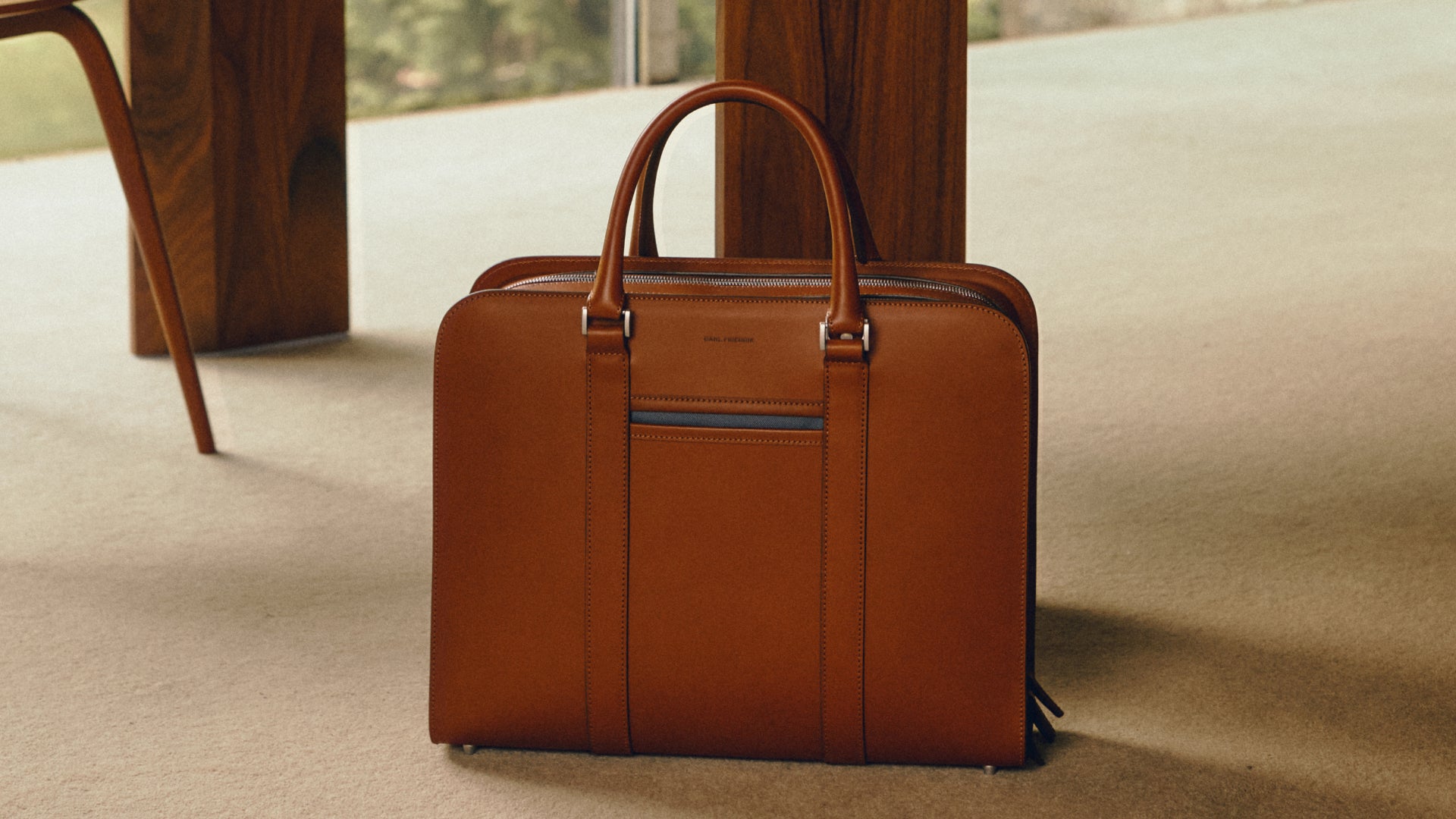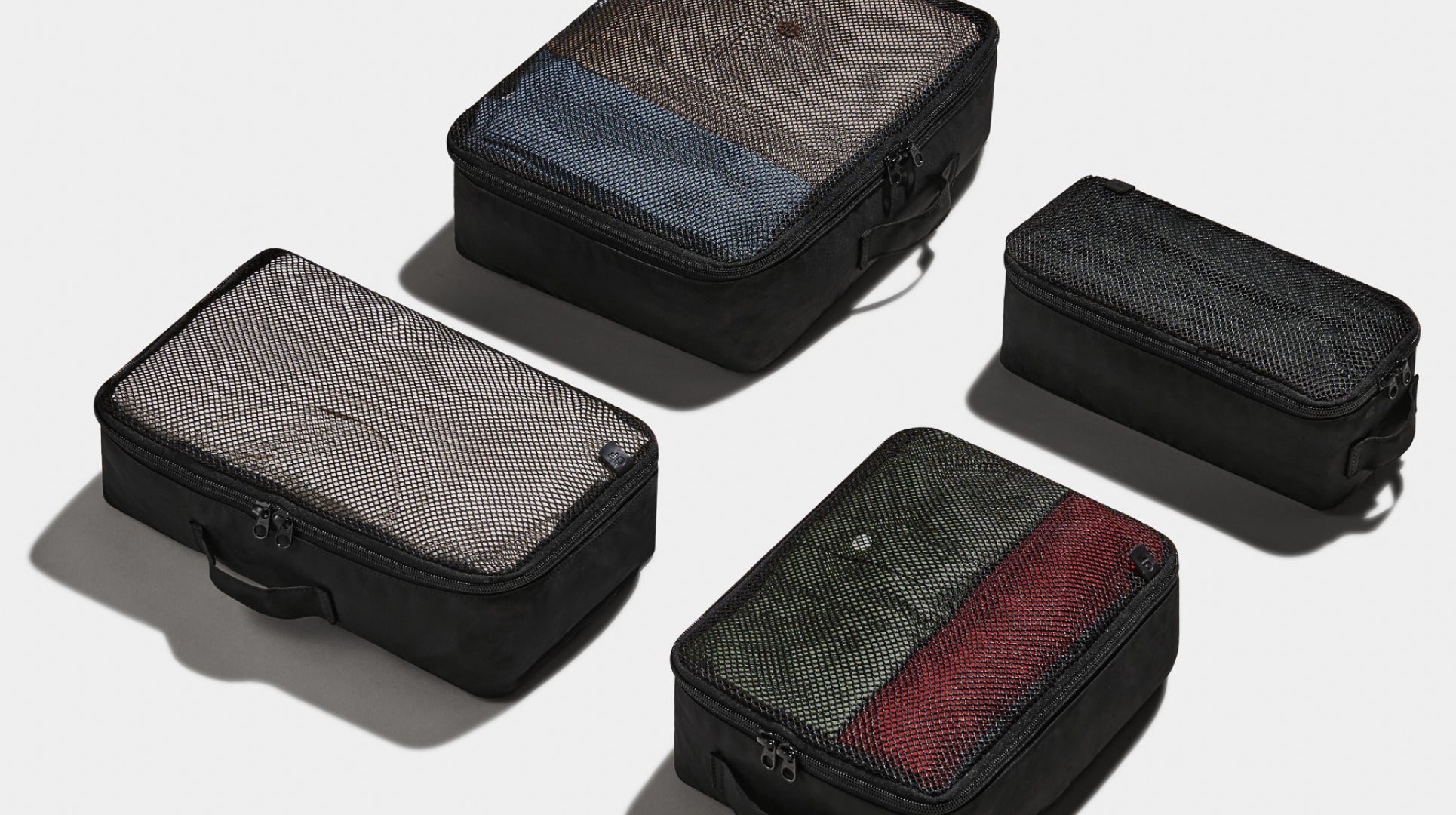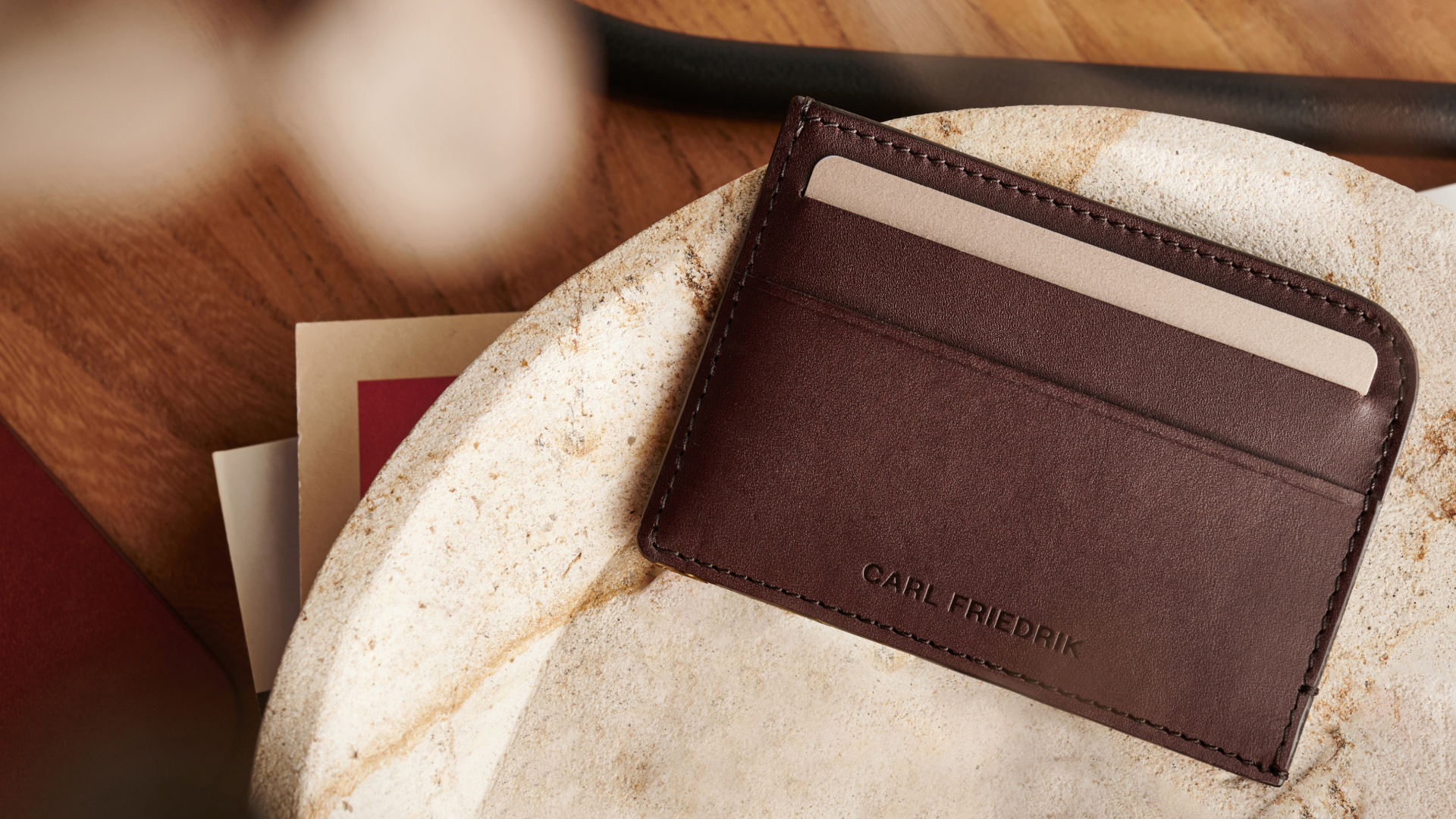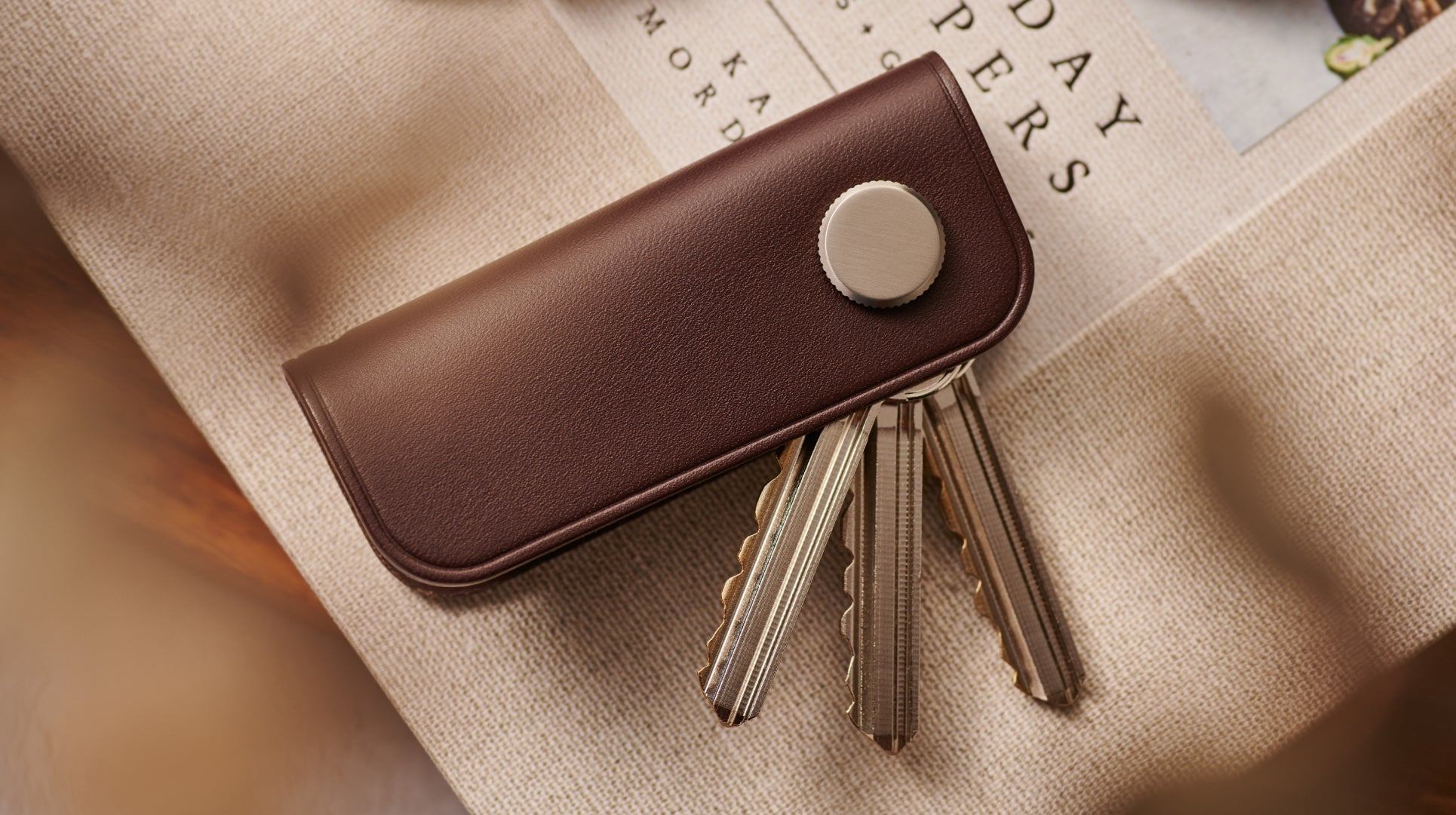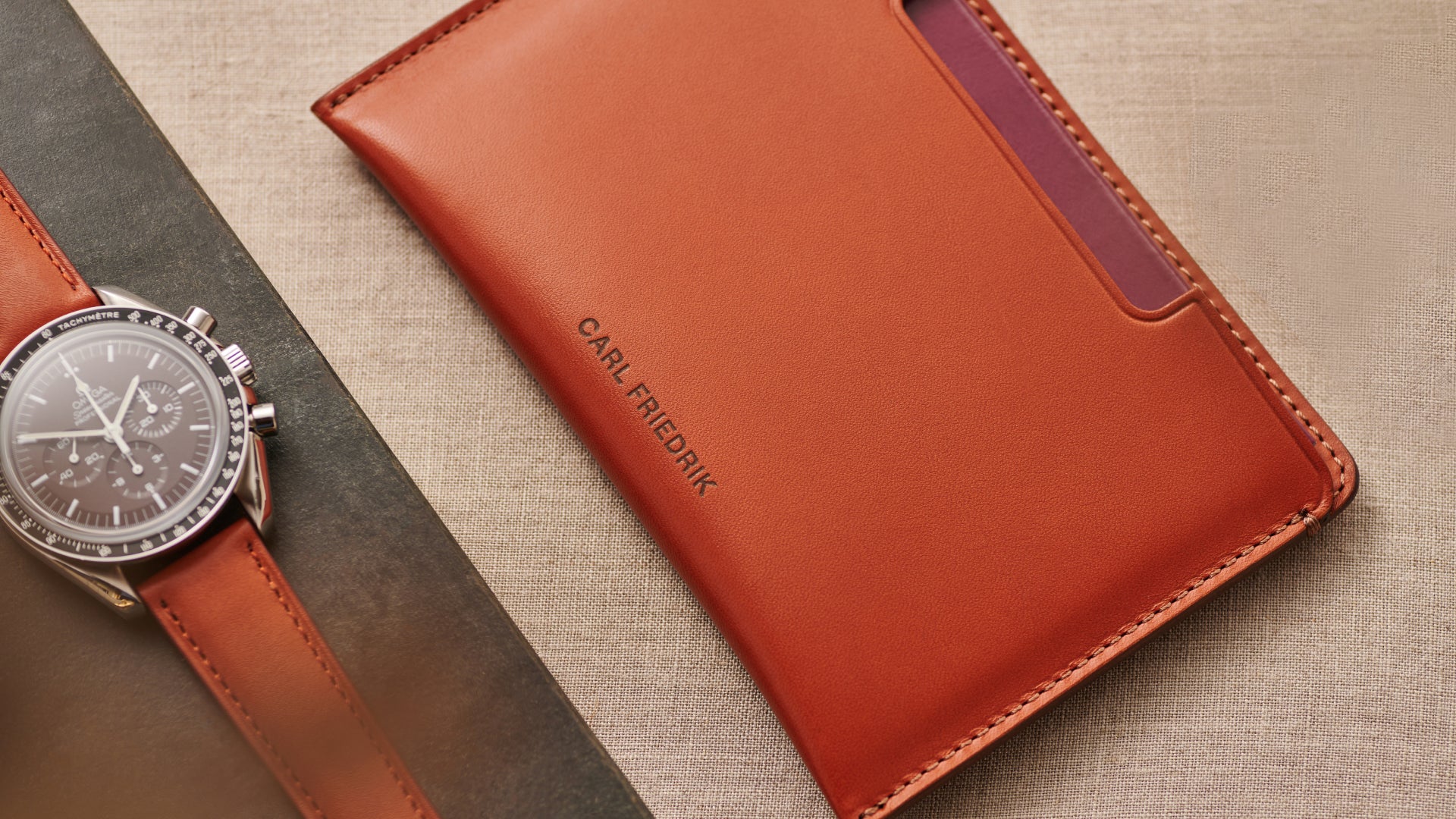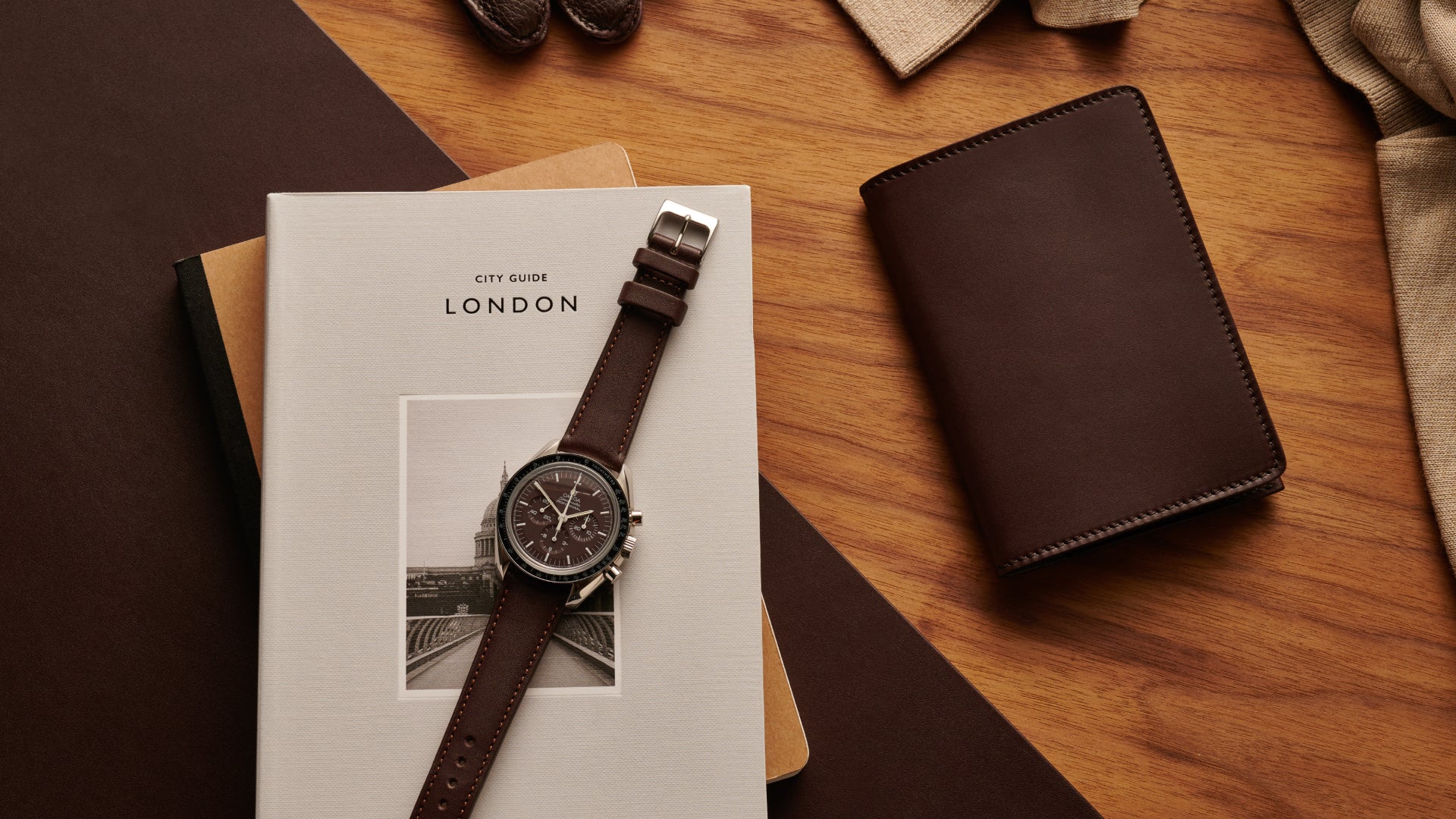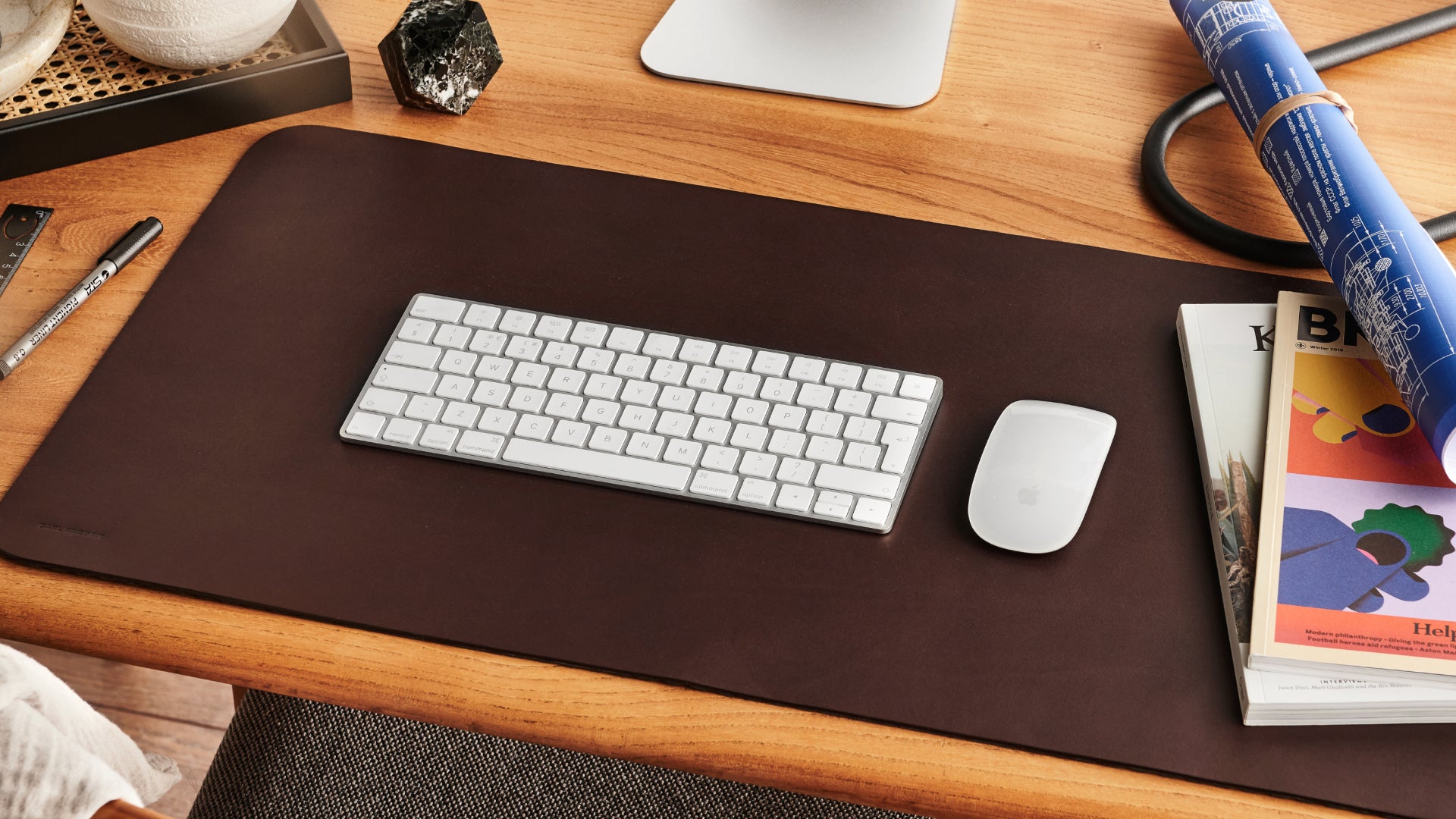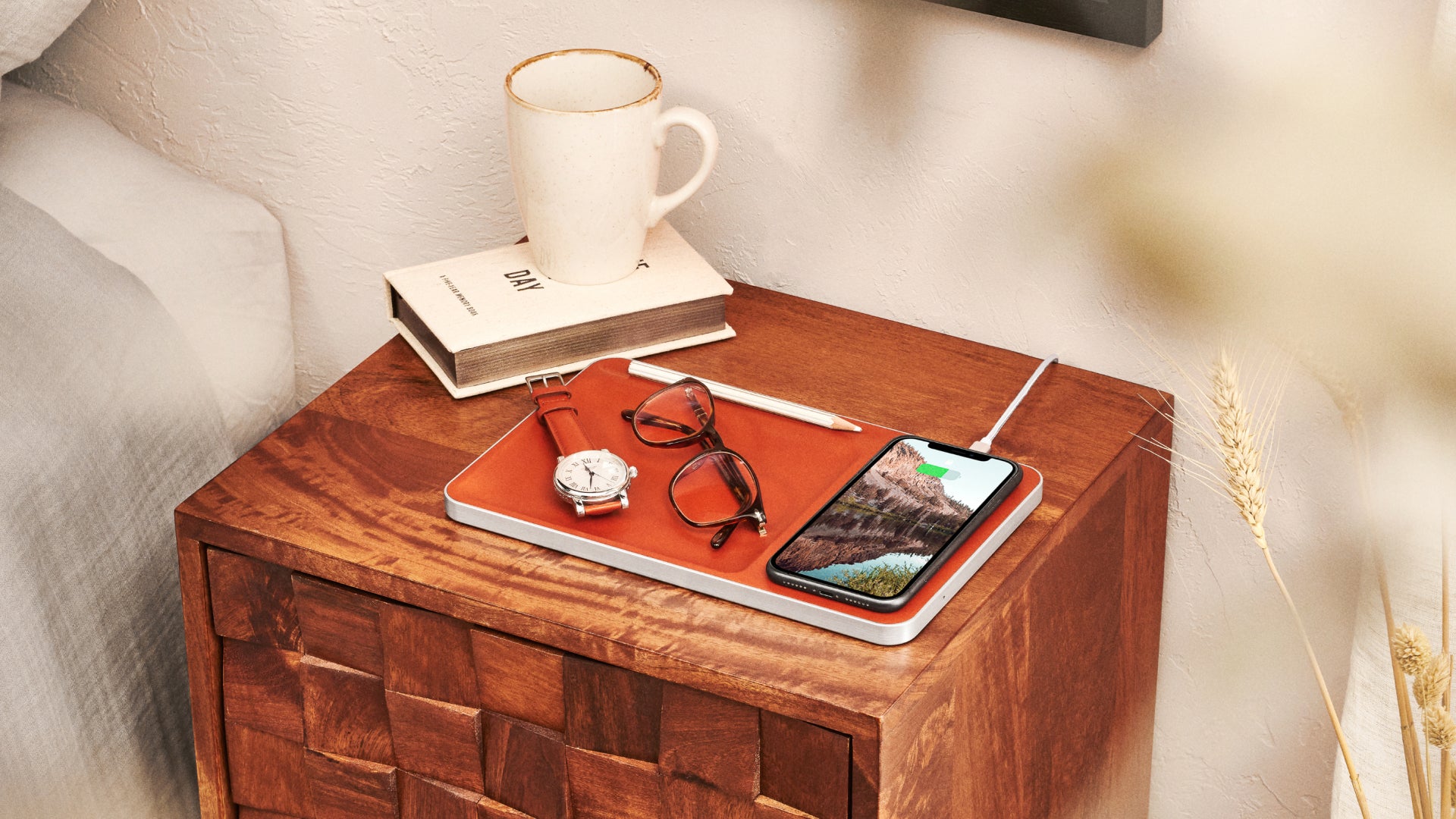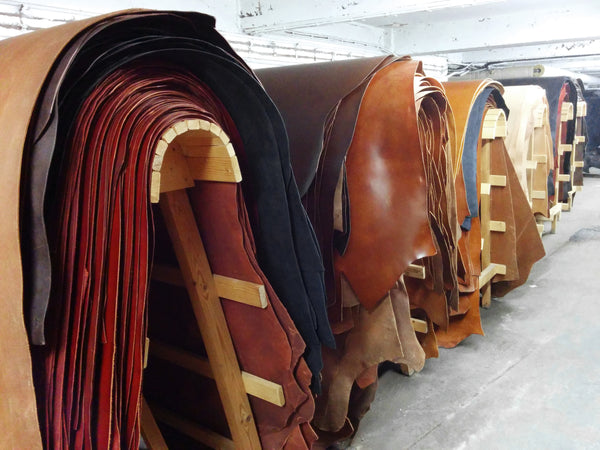From synthetic vegan leathers to napped varieties like nubuck, there’s an impressive selection of leathers available today. But one kind that certainly stands out from the rest is patent leather.
Characterised by its shiny appearance and unique physical attributes, the material has enjoyed a popular resurgence of late. Chances are if you stroll down a busy high street, you'll quickly spot a pedestrian sporting a chic patent leather trench coat or handbag.
So what is patent leather? What are the benefits? And how is patent leather made? Keep reading for the answer to these questions and more.

What is patent leather?
A type of coated leather, patent leather’s glossy, lustrous finish makes it instantly recognisable. Virtually waterproof, it is renowned for being flexible, soft and requiring virtually no maintenance. These characteristics stem from the coating applied to the leather, which was historically oil-based but is now commonly synthetic (generally involving a combination of polyurethane and acrylic).
This shiny leather is typically solid black, but can also be found in many other colours. While patent leather has long been synonymous with wealth or, at the very least, grandeur — think designer shoes by French and Italian fashion houses — the material is now widespread and affordable. Falling costs are the result of innovations in the production process, but more on this later.

Advantages of patent leather
- Versatility
- Low maintenance
- Waterproof
- Signature, glossy appearance
- Dirt resistance
- Price point
Patent leather boasts a wide selection of desirable characteristics. The presence of acrylic in the coating applied to patent leather makes it highly flexible, meaning it's less likely to crack and peel than natural leathers. And given that patent leather is thin and pliable, manufacturers can employ it to make a varied range of products, from belts to boots.
So, is patent leather durable? The answer is debatable, but its waterproof and dirt-resistant qualities certainly suggest a degree of robustness. It is worth noting that these qualities stem entirely from the lacquer, which provides a protective layer, preventing moisture and dirt from penetrating the fibres in the leather. Dirt can be easily removed from the surface of patent leather with mild soap and a wet cloth. Unlike natural leather, no conditioning is required — a conditioner wouldn't even be able to penetrate the surface.
That brings us to the favourable price point. As previously mentioned, the majority of patent leather products are now made from various kinds of cheaper synthetic leathers. Only premium patent leather goods are likely to start with a base layer of full-grain, natural leather.

Disadvantages of patent leather
- Discolouration and darkening
- Prone to scuffs and scratches
- Chemical our
- No patina
- Can become sticky
- Creases and cracks are irreversible
Patent leather tends to degrade over time and is extremely challenging to restore because the exterior coating is made from a combination of plastics. Discolouration is a common phenomenon. When, for example, you place a light-coloured patent leather handbag beside a darker product for an extended period, colour migration is likely to occur (see the image below). Discolouration also happens if the material is frequently exposed to UV rays — worth bearing in mind if you’re a sun-worshipper.
Another downside is that this glossy leather is especially susceptible to scratches and scuffs (though minor issues can be removed by applying treatments). Although cracks and creases are less likely to form, they are often irreversible once they have appeared. You might also be wondering, given the glossy finish, is patent leather tacky? Interestingly, it can easily become sticky: the result of plastics on the surface gradually breaking down.
Unlike specific varieties of natural leather, patent leather will never form a patina, as the surface is not permeable: enough to deter some leather enthusiasts from embracing it. Lastly, while natural leather benefits from a rich, earthy smell, its shiny cousin typically possesses a less pleasant, chemical odour. You guessed it — this also boils down to the plastic-based coating.

Evolution of patent leather
The history of patent leather is one of gradual progression and improvement. An 1793 reference to the material in The Bee, a short-lived British literary magazine, tells of a Mr Hand from Birmingham, England, who had obtained a patent for a new kind of ‘flexible leather.. [with]... a glaze and polish that renders it impervious to water’. Allegedly, this is how patent leather acquired its name. At this point, it was used to create luxurious shoes for the privileged upper-classes.
The next thirty years witnessed a spur of innovation. In 1799, the inventor Edmund Prior earned a legal patent for establishing a new coating technique. His method relied on a combination of dies and boiled oil, and finishing the leather with the addition of oil varnish. Next came fellow London-based inventor, Charles Mollersten, whose concoction of whale oil, linseed oil, lamp black and horse grease gave his leather an especially shiny surface; he too received a legal patent in 1805.
It is Seth Boyden, however, who is widely regarded as the central figure in popularising patent leather and paving the way for commercial production, especially in the US. His 1819 coating method revolved around the repeated application of linseed oil. Ironically, he never patented the process.
Wider scientific developments related to the application of plastics led inventors to experiment with synthetic coatings in the late 19th century. The effect was to drive down the cost of producing patent leather, paving the way for the mass consumption of patent leather consumer goods. The discovery of polyurethane in 1937 was a crucial step in this process; the polymer is is still invaluable to the manufacturing of patent leather today.
While patent leather was historically made using high-quality, natural calf leather, it has gradually been replaced by (cheaper) faux, or ‘imitation’, leathers in the latter 20th century and beyond. Given that the natural characteristics of premium leather are negated when covered with the finishing lacquer, this makes no overall difference to the longevity of products. The upside is that faux patent leather products are considerably more affordable.

Table comparing patent leather vs leather
| Patent leather | Natural, vegetable-tanned leather | |
|
Texture |
Smooth, glossy, polished | Buttery-soft, somewhat oily |
| Durability | Resistant to dirt and water, but prone to discolouration and scuffs, and will degrade over time | Extremely durable, can last a lifetime |
| Used for | Predominantly apparel and accessories | Everything from upholstery to saddlery, briefcases, wallets and footwear |
| Price | Generally inexpensive | More expensive than inferior varieties of leather |
| Maintenance | Very easy to maintain | Requires semi-regular conditioning to prolong shelf life |
| Patina | No patina | Will form a patina over time |
| Smell | Chemical-like | Rich, earthy |
Uses of patent leather
Many consumer goods are manufactured using patent leather. The shiny, luxurious finish of the material lends itself well to formal accessories, but it’s also leveraged to produce an array of everyday goods: outerwear, backpacks, belts, wallets and watch straps to name a few.
Footwear is perhaps the most well-documented use of patent leather. As far back as the early 19th century, cordwainers (shoemakers) took advantage of the material’s lustrous appearance to produce upmarket dance and dress shoes. Patent leather’s association with opulence stuck throughout the decades. Men’s tuxedo footwear almost always features a glossy, patent leather finish. While the signature stiletto-heels designed by French fashion brand, Christian Louboutin, are renowned for their lacquered soles.
Patent leather fashion has once again been popularised by online retailers like ASOS and Zara, as well as haute couture behemoths; while Hermes designs and sells patent leather handbags, Coach creates luxurious tote bags and Valentino makes shoes.
Today’s cyclical fashion continues to be influenced by the patent leather hype of the Sixties. A decade when miniskirts, knee-high boots and trench coats made from the material played an important role in reshaping cultural values and women’s position in society.

How to clean patent leather
It is the morning after the night before and your treasured pair of patent leather Derby shoes are looking a little worse for wear. Thankfully, the layer of protective lacquer shielding all patent leather goods means they are relatively easy to clean. In fact, many common household items — from petroleum jelly to kitchen oils and liquid soap — can be used as cleaning agents. There’s no need to replenish cracked fibres with a moisturising conditioner, as is the case with animal leather.
Start by taking a soft brush (never hard-bristled, this could lead to scratches) and gently remove any dirt or debris, paying close attention to cracks and crevices. Mix a small amount of mild liquid soap in a bowl with lukewarm water. Lightly wet a microfibre cloth and spot test a concealed area to determine if any lint or colour is transferred onto the surface. If it passes the test, gently clean the rest of the surface and leave the product to dry for 24 hours before the next use.
If you don’t have access to the above, mild baby wipes and pre-moistened wet wipes are two other practical solutions for cleaning patent leather. After use, remove any remaining surface moisture with a dry cloth or even a piece of tissue; otherwise, the moisture can stain and reduce the shininess. Remember also to read the ingredients to ensure there are no toxic chemicals in the wipes.
For extra tough stains, we recommend applying a patent leather cleaner via a microfibre cloth.

How to remove scuffs from patent leather?
Scuffs naturally crop up on patent leather accessories when they are worn frequently, but often they can easily be buffed out. Try smearing a small amount of petroleum jelly on a microfibre cloth and then rubbing it in a gentle, circular motion over the affected area(s). Allow the petroleum jelly to rest on the surface for around 20-30 minutes. Then simply wipe it off using a dry cloth and the surface should be scuff-free. For significant abrasions, apply olive oil instead.
How to shine patent leather?
Arguably the best part about patent leather is that signature glossy, luxurious shine. To restore it, we recommend investing in a patent leather cleaner. You’ll want to apply a generous amount to a microfibre cloth, then rub it onto your product in circular motions. Leave it to dry for approximately 5 minutes (you’ll know it's time because the surface becomes slightly foggy) and then buff the entire surface using a dry part of the cloth.
How to store patent leather?
Excessive exposure to UV radiation (such as sunlight) can cause patent leather products to become discoloured. So it’s important to store these products away from natural light. That said, certain patent leathers are now finished with chemicals that promote UV resistance, so it's always worth checking this.
Interestingly, lighter-coloured patent leather — think shades of white and cream — can also absorb colours from other products. So if they’re sold with a garment bag, that’s always the best place to store them. Failing that, store them in a shielded space, such as a shoetree, cupboard or drawer.

How is patent leather made?
Animal hides destined to become patent leather undergo a largely similar tanning process to almost all other types of leather. You can read about tanning in more detail here. But essentially, after hides arrive at a tannery they are prepared for tanning — which at a minimum involves soaking, liming and bating — and then undergo the tanning phase itself, during which they are transformed into leather.
At this point, different chemical treatments and techniques can be employed to produce all kinds of leather, from vinyl to bonded. But a patent finish (synthetic resin coating) is applied to tanned leather to give it a distinctively shiny look and glossy texture.
In the past, applying the protective lacquer was a time-consuming, manual process. Tanners would begin with premium bovine leather and gradually apply coats of oil-based varnish to it — sometimes up to 20. Every time a layer was applied, the wet leather had to be dried on top of a stove or outside in the sun.
Modern techniques are mechanised and more efficient. And instead of natural oils, tanneries now use a synthetic blend of polyurethane and acrylic to create a patent finish. The former is responsible for hardness and the signature glossy look, while the latter gives a necessary degree of flexibility. The challenge for tanners is finding the perfect balance between the two, ensuring the leather has the right texture and properties.
Spray application was once the most popular method for applying the protective coating. However, the process was inefficient at providing both the thick coatings and depth of gloss required. The almost entirely mechanised curtain coating technique is now preferred. Tanners begin by loading a tank with the liquid synthetic coating. Unfinished leather moves on a conveyor belt under the tank and is uniformly coated in the lacquer. The wet leather continues along the conveyor belt into a heated tunnel, where it quickly solidifies. This process is completed two more times, with the final coat providing the desired glossy finish and waterproof qualities.

Takeaway
Patent leather is a much celebrated material because it’s water-resistant, extremely easy to maintain and has a unique visual presence amongst other leathers.
It's worth evaluating whether you prefer the characteristics of this (commonly) synthetic leather or natural animal leather when you're next in the market for a leather good.
